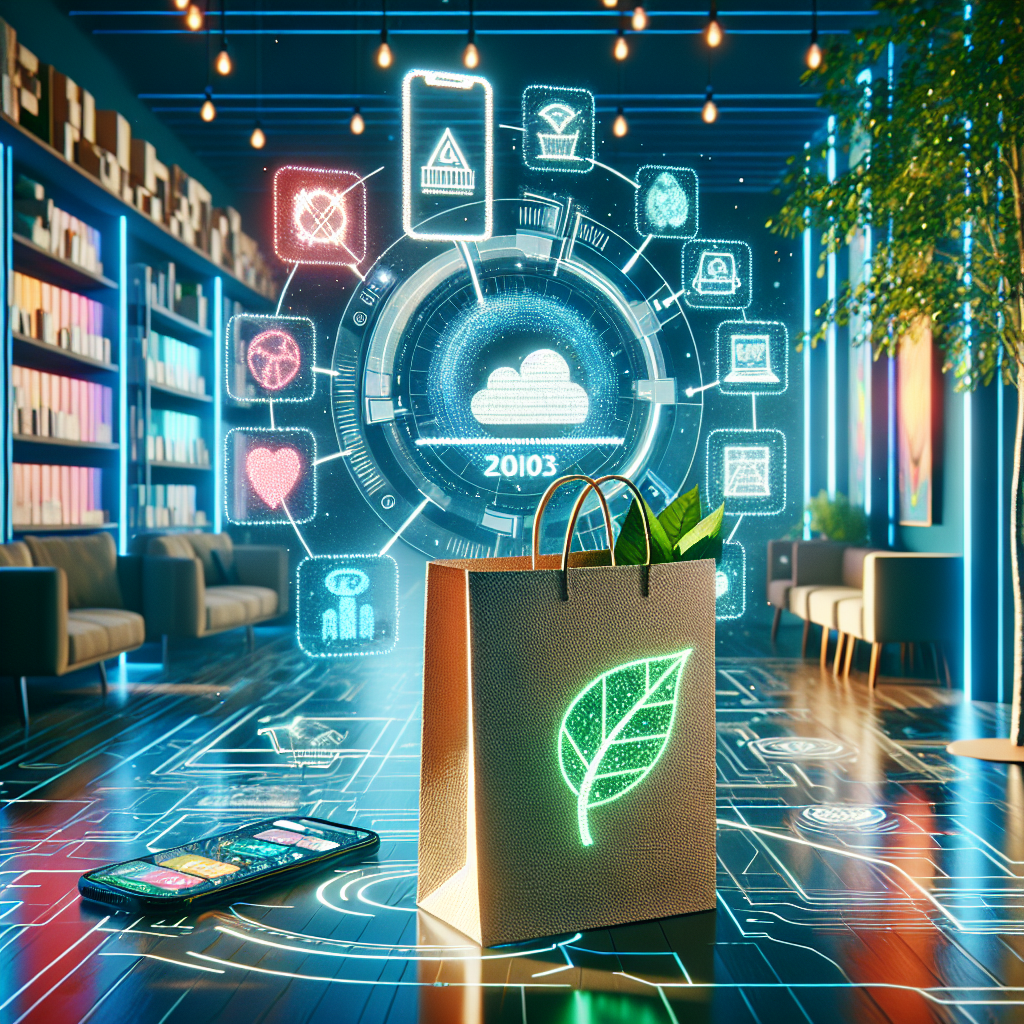The world of online shopping continues to evolve at a rapid pace, and 2023 is no exception. With the advancement of technology and shifting consumer behaviors, new trends are emerging that are set to redefine the e-commerce landscape. Whether you’re a savvy shopper or a business owner, staying updated with these online shopping trends is crucial to making informed decisions and staying competitive in the market.
One of the most noticeable trends this year is the increased focus on personalization. Shoppers are looking for customized experiences that cater to their individual preferences and needs. Retailers are leveraging data analytics and artificial intelligence to offer personalized recommendations, exclusive deals, and tailored content that enhance customer satisfaction and loyalty.
In addition, sustainability has become a significant factor influencing online shopping choices. Consumers are increasingly aware of the environmental impact of their purchases and are opting for eco-friendly products and practices. Brands that prioritize sustainability and transparency in their operations are gaining favor among conscientious shoppers.
Furthermore, the growth of mobile shopping cannot be overlooked. With smartphones becoming more integral to our daily lives, a seamless mobile shopping experience is more important than ever. Retailers are optimizing their websites and apps to ensure fast, user-friendly navigation and secure transactions on mobile devices.
Stay ahead of the curve and embrace these exciting trends by exploring our wide range of high-quality discounted items with free and fast shipping. Shop Now!

In 2023, personalized shopping experiences are taking center stage as consumers crave a more tailored and unique interaction with brands. The days of one-size-fits-all shopping are long gone, replaced by sophisticated algorithms and data-driven approaches that allow retailers to cater to individual preferences.
By leveraging artificial intelligence and machine learning technologies, e-commerce platforms can analyze vast amounts of customer data to offer personalized recommendations. This not only enhances the shopping experience but also increases the likelihood of purchase, as customers feel understood and valued. For instance, online stores can suggest products based on past purchases, browsing history, and even real-time behavior on the site.
Email marketing has also evolved with personalization at its core. Instead of generic newsletters, customers now receive emails that address them by name and include product recommendations that are relevant to their tastes and needs. This targeted approach significantly improves engagement rates and drives more traffic to websites.
Moreover, personalization extends to the entire customer journey, from the moment they land on a website to the post-purchase follow-ups. Dynamic content, such as personalized landing pages and customized product offerings, ensures that each customer feels like the experience is designed just for them. This level of attention not only boosts customer satisfaction but also fosters brand loyalty.
As we move further into 2023, the emphasis on personalization is only expected to grow. Retailers who invest in these technologies and strategies will be better positioned to attract and retain customers in an increasingly competitive online marketplace.

The rise of sustainable e-commerce is a significant trend in 2023, reflecting a growing consumer demand for environmentally responsible shopping options. Shoppers are increasingly aware of the environmental impact of their purchases and are seeking out brands that prioritize sustainability.
This shift is driving retailers to adopt more eco-friendly practices throughout their supply chains. From sourcing materials responsibly to reducing carbon footprints, companies are rethinking their processes to align with the values of their environmentally-conscious customers. Many brands are now opting for sustainable packaging solutions, such as biodegradable or recyclable materials, to minimize waste.
Additionally, there is a notable increase in the popularity of products that promote sustainability. Items made from recycled materials, organic ingredients, and ethical labor practices are gaining traction as consumers look to make more responsible choices. This trend is not only limited to the products themselves but also extends to the overall shopping experience. For example, some e-commerce platforms now offer carbon-neutral shipping options, allowing customers to offset the environmental impact of their deliveries.
Transparency has become a key component of sustainable e-commerce. Brands that openly share their sustainability efforts and progress are more likely to build trust and loyalty with their customers. Detailed information about the origins of products, the environmental impact of production, and the steps being taken to improve sustainability can make a significant difference in consumer perception and decision-making.
As we continue through 2023, the emphasis on sustainability in e-commerce is expected to intensify. Retailers who embrace these practices and communicate their efforts effectively will not only contribute to a healthier planet but also gain a competitive edge in the marketplace.

The growth of mobile shopping is one of the most notable trends in 2023, as consumers increasingly rely on their smartphones for online purchases. The convenience and accessibility of mobile devices have revolutionized the way people shop, making it easier than ever to browse and buy products on the go.
One of the key drivers of this trend is the widespread adoption of mobile payment solutions. Technologies like Apple Pay, Google Wallet, and various other digital wallets have simplified the checkout process, allowing users to complete transactions quickly and securely with just a few taps. This ease of use has significantly reduced cart abandonment rates and enhanced the overall shopping experience.
Moreover, retailers are optimizing their websites and apps to be mobile-friendly, ensuring that the user interface is intuitive and responsive. Features such as one-click purchasing, personalized recommendations, and augmented reality (AR) try-ons are becoming standard, providing a seamless and engaging shopping experience on mobile devices.
The rise of social commerce is another factor contributing to the growth of mobile shopping. Social media platforms like Instagram, Facebook, and TikTok have integrated shopping features, allowing users to discover and purchase products directly within the apps. This fusion of social interaction and e-commerce has created new opportunities for brands to reach and engage with their target audiences.
Additionally, mobile shopping apps are leveraging advanced technologies like artificial intelligence (AI) and machine learning to offer personalized experiences. By analyzing user behavior and preferences, these apps can suggest products that are more likely to appeal to individual shoppers, thereby increasing conversion rates and customer satisfaction.
As mobile technology continues to evolve and improve, the growth of mobile shopping shows no signs of slowing down. Retailers that prioritize mobile optimization and innovative features will be well-positioned to capture the attention and loyalty of today’s tech-savvy consumers.

The impact of social commerce in 2023 cannot be overstated. As social media platforms continue to evolve, they are increasingly becoming integral to the e-commerce landscape. Social commerce, which merges social media and online shopping, allows consumers to discover, research, and purchase products directly through social media channels.
One of the primary reasons for the growing influence of social commerce is the seamless integration of shopping features within popular social media platforms. For instance, Instagram’s shoppable posts and stories, Facebook’s Shops, and TikTok’s in-app purchase options enable users to buy products without leaving the app. This convenience reduces friction in the purchasing process, leading to higher conversion rates.
Social commerce thrives on the power of social proof. User-generated content, such as reviews, ratings, and testimonials, plays a crucial role in influencing purchasing decisions. Consumers are more likely to trust recommendations from friends, family, and influencers they follow, which can significantly boost a brand’s credibility and sales.
Influencer marketing is another significant aspect of social commerce. Influencers, who have built a loyal following, can effectively promote products to their audience through authentic and engaging content. This form of marketing leverages the trust and rapport influencers have with their followers, making it a powerful tool for driving sales.
Moreover, social media platforms use advanced algorithms and data analytics to deliver personalized shopping experiences. By analyzing user behavior, interests, and preferences, these platforms can present relevant product recommendations, making it easier for consumers to find items they are likely to purchase.
The interactive nature of social media also facilitates real-time engagement between brands and consumers. Features like live streaming and chat support allow brands to showcase products, answer questions, and address concerns instantly, enhancing the overall shopping experience.
As social media continues to integrate more sophisticated shopping features and expand its reach, the impact of social commerce will only grow stronger. Brands that harness the potential of social commerce are well-positioned to thrive in the competitive e-commerce market.
The importance of fast and free shipping in online shopping cannot be underestimated, especially in 2023. As e-commerce continues to evolve, customer expectations are higher than ever. Shoppers not only seek quality products but also demand quick and cost-effective delivery options.
Offering fast and free shipping is a key factor in reducing cart abandonment rates. Studies show that high shipping costs and long delivery times are among the top reasons shoppers abandon their carts. By providing free shipping and ensuring swift delivery, retailers can significantly improve their conversion rates and customer satisfaction.
Additionally, fast and free shipping enhances the overall customer experience. In a highly competitive market, it is the small details that set a brand apart. A seamless and speedy delivery process can lead to repeat purchases and foster customer loyalty. When customers know they can rely on a retailer to deliver their orders promptly, they are more likely to return for future purchases.
Moreover, fast and free shipping can be a compelling marketing tool. Retailers can use this perk to attract new customers and stand out from competitors. Prominent advertising of free shipping offers can drive traffic to a website and increase sales. It can also be a deciding factor for customers comparing similar products from different retailers.
From a logistical standpoint, providing fast and free shipping may require strategic planning and investment. Retailers need to optimize their supply chains, partner with reliable carriers, and possibly establish multiple distribution centers to ensure efficient delivery. However, the benefits of meeting customer expectations and gaining a competitive edge often outweigh the costs involved.
In conclusion, fast and free shipping is no longer just a nice-to-have feature; it is a necessity for e-commerce success. Retailers that prioritize this aspect of their operations are likely to see significant improvements in customer satisfaction and business growth.
Experience the benefits of fast and free shipping firsthand. Shop Now!
Leave a comment